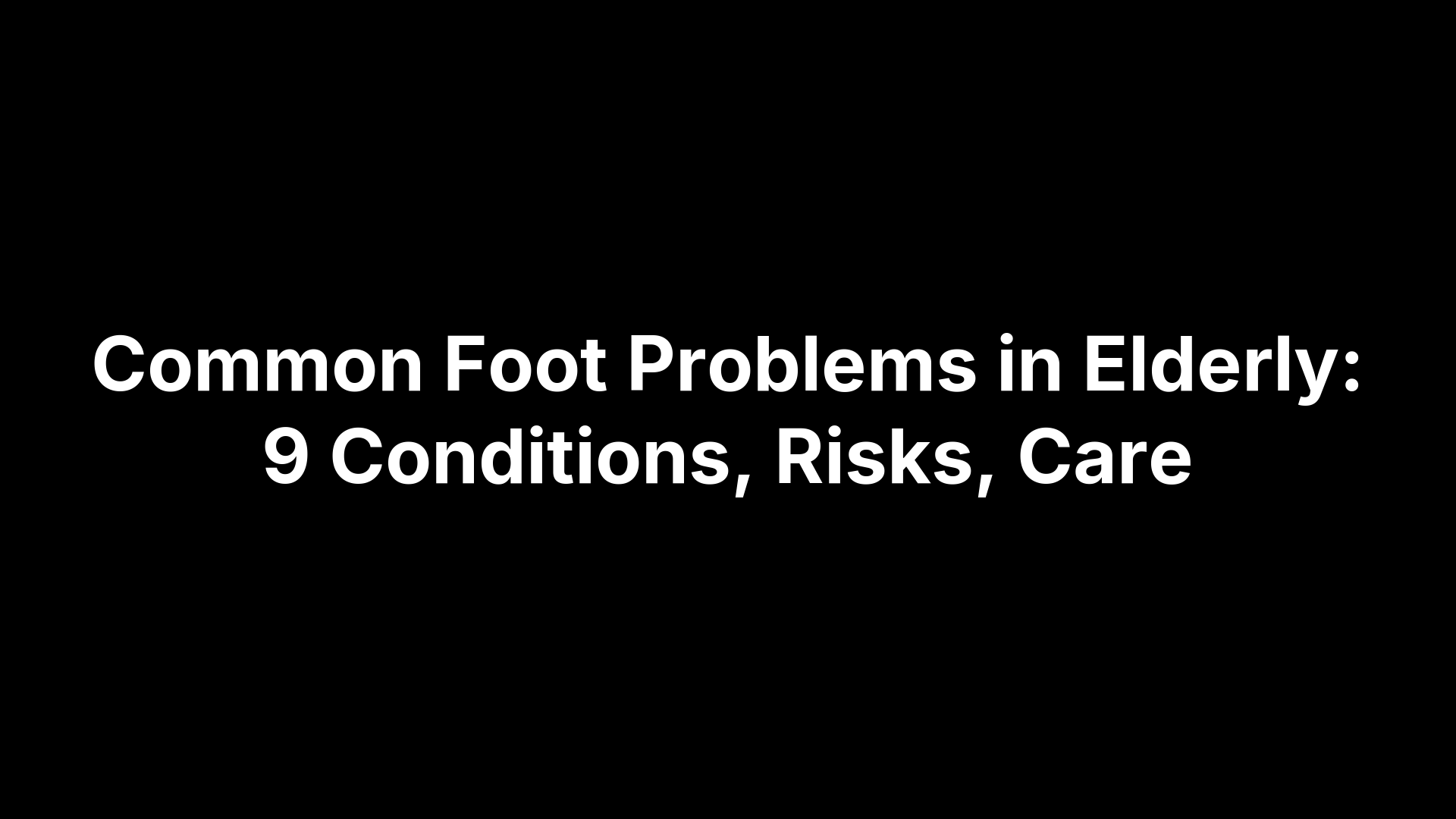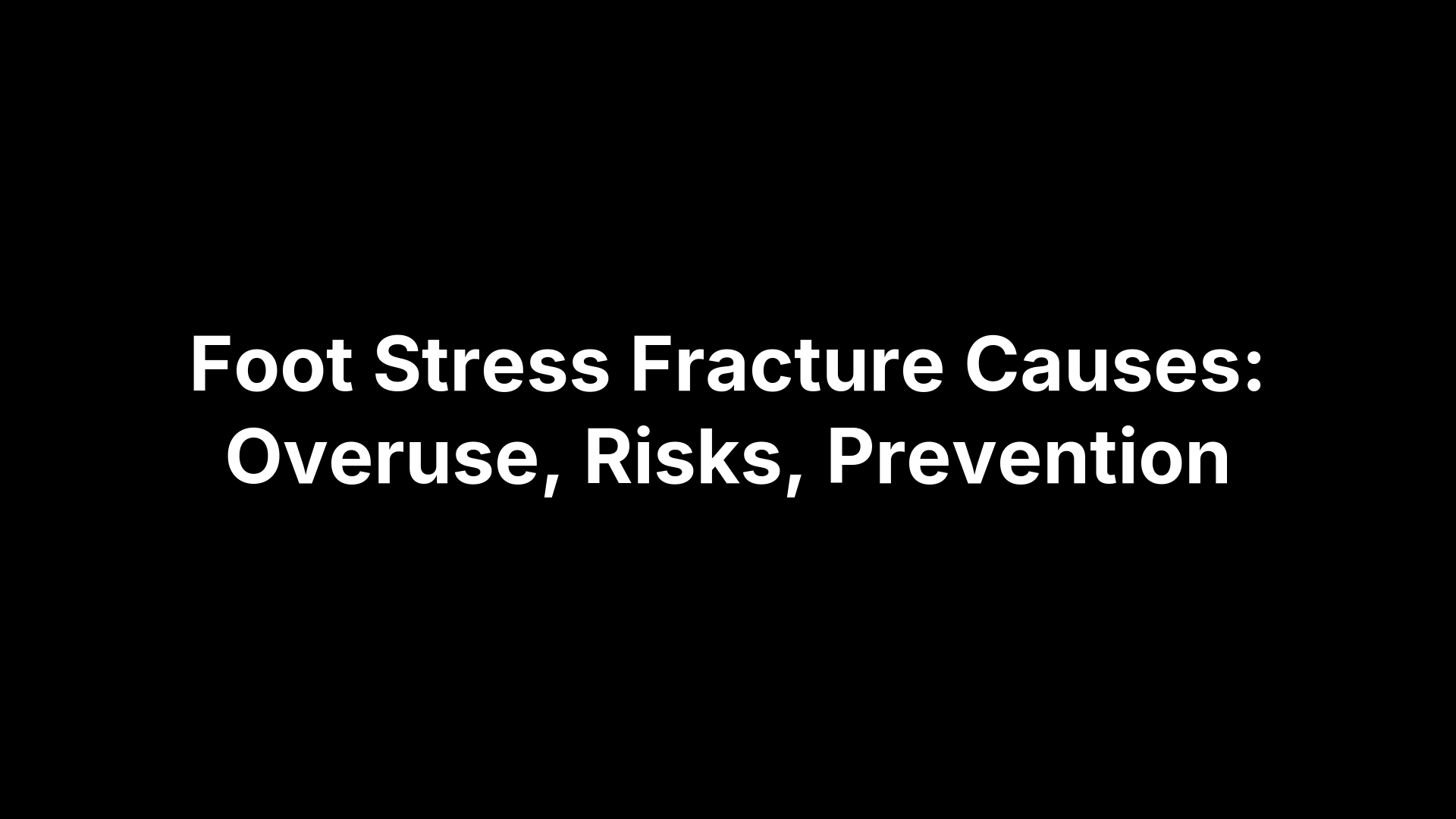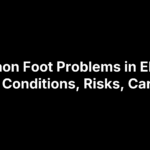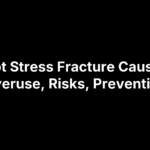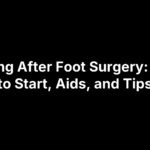Regenerative medicine is a treatment approach that helps the body repair itself. In musculoskeletal care, that often means using your own cells, platelets, and growth factors (sometimes called “orthobiologics”) to reduce pain and support healing in injured or worn tissues. Common examples include platelet-rich plasma (PRP) and bone marrow or fat–derived cell concentrates. Some techniques also use engineered scaffolds that guide tissue repair. These therapies aren’t miracle cures or one-size-fits-all; they aim to restore function, ease symptoms, and in some cases postpone or avoid surgery.
In this guide, you’ll learn how regenerative medicine works, which therapies you’re likely to hear about, and the foot and ankle problems it may help. We’ll cover realistic benefits, what current research shows, safety and side effects, who’s a good candidate, and what to expect before, during, and after treatment. You’ll also find details on how long results last, costs and insurance, FDA status, how it compares to other options, and how to choose a qualified provider.
How regenerative medicine works
At its core, regenerative medicine taps into your body’s built-in repair system. In orthopedics, that typically means concentrating healing signals from your own blood, fat, or bone marrow and placing them exactly where tissue is injured. Those cells, platelets, and growth factors don’t “become” new tissue; they release bioactive cues that calm inflammation, recruit your native repair cells, and support collagen and extracellular matrix remodeling. Some treatments also add a temporary scaffold that gives new tissue a framework to grow on.
- Evaluation: A clinician confirms the diagnosis and whether a regenerative option is appropriate for your goals and condition.
- Harvest: A simple blood draw (PRP) or a short bone marrow or adipose (fat) harvest is performed.
- Minimal processing: Your own sample is prepared and concentrated, then returned within the same procedure.
- Guided delivery: The injectate is placed precisely into the target tissue using ultrasound or fluoroscopic guidance.
- Rehab support: Activity modification, bracing, and physical therapy help the biology take hold.
Results build gradually over weeks to months. These therapies aren’t universal cures or automatic substitutes for surgery, and some conditions may need repeat treatments over time to maintain benefits.
Common therapies you may hear about
When people talk about regenerative medicine in orthopedics, they usually mean orthobiologics made from your own blood, bone marrow, or fat that are minimally processed and placed back into the injured area the same day. Evidence and outcomes vary by condition, and clinical trials are ongoing under FDA oversight. Here are the options you’ll hear about most often and what they aim to do.
-
Platelet-rich plasma (PRP): A small blood draw is spun to concentrate platelets and their growth factors, then injected into the target tissue. Protocols have improved in recent years, and studies report clinically meaningful benefits in tendinopathies and for arthritis-related pain relief in some joints.
-
Bone marrow aspirate concentrate (BMAC): Bone marrow from the pelvis is concentrated to deliver repair cells and signaling molecules. It’s used in select orthopedic conditions; for example, in a Mayo Clinic series for corticosteroid-induced hip osteonecrosis, over 90% of treated hips avoided collapse at two years after decompression plus BMAC and PRP.
-
Adipose-derived cell concentrates: Fat tissue contains stromal vascular fraction (SVF) with supportive cells and signals. These treatments are investigational; randomized trials (including for knee arthritis) are in progress to clarify safety and effectiveness.
-
Biomaterial scaffolds/ECM: Natural or synthetic matrices can provide a framework for tissue repair. In musculoskeletal care, these are used selectively and are largely part of research or specialized surgical applications. Regardless of therapy, image-guided delivery and pairing with rehab improve the chances of a good outcome.
Foot and ankle problems it may help
In the foot and ankle, regenerative medicine is most often used for stubborn soft‑tissue problems and early arthritis that haven’t responded to rest, bracing, orthotics, or physical therapy. Image‑guided injections of PRP or cell concentrates are placed into irritated, degenerative tissue to dial down inflammation and support remodeling. Because PRP has shown clinically meaningful benefit in tendinopathies, many candidates are people with chronic heel or ankle tendon pain who want to stay active and, when possible, delay bigger procedures.
- Plantar fasciopathy (chronic heel pain): Persistent fascia pain that lingers beyond standard care.
- Achilles tendinopathy: Mid‑portion or insertional tendon pain not improving with loading programs.
- Peroneal or posterior tibial tendinopathy: Lateral or medial ankle tendon overuse and degeneration.
- Mild‑to‑moderate ankle or midfoot arthritis pain: For patients seeking nonoperative symptom relief.
- Post‑procedure biological support: As an adjunct to selected surgical repairs in appropriate cases.
These therapies are not cures for severe arthritis or structural deformity, and they aren’t substitutes for necessary surgery. Some patients experience pain relief and better function for up to a year or longer, but repeat treatments may be needed over time. Pairing biologics with activity modification, bracing, and targeted rehab improves the odds of success.
Benefits you can realistically expect
If you’re picturing a miracle shot that rebuilds a joint overnight, that’s not what regenerative medicine does. In foot and ankle care, these therapies aim to dial down pain and support your body’s own repair so you can move better with fewer flare‑ups. When used for the right problem—and paired with smart rehab, bracing, and activity changes—many patients notice gradual gains over weeks to months. Mayo Clinic reports that pain relief and functional improvement can last up to a year or longer for some, but most procedures aren’t cures and may need to be repeated over time.
- Less pain, better function: Many people report meaningful symptom relief and easier daily movement.
- Potential to delay bigger procedures: Can fill the gap when PT, bracing, or prior injections haven’t helped, and surgery isn’t ideal yet.
- Targeted, minimally invasive care: Office‑based, image‑guided injections place healing signals exactly where they’re needed.
- Support for stubborn soft‑tissue problems: Especially tendinopathies, where PRP has shown clinically beneficial effects.
- Adjunct to selected surgeries: Biologics may be used alongside repairs to support healing in appropriate cases.
Results vary by diagnosis and individual biology; severe arthritis or structural deformity typically needs different solutions.
What the research says today
If you cut through the marketing, today’s best evidence in orthopedic regenerative medicine centers on platelet‑rich plasma (PRP) for chronic tendinopathies and selected arthritis pain. Mayo Clinic reports that PRP protocols have been refined and standardized, with clinically meaningful benefits in tendinopathies and pain relief for knee osteoarthritis in some patients. Benefits build over weeks to months and, while improvements can last a year or longer for some, repeat treatments are often needed and these are not cures.
Cell‑based concentrates are promising but remain more investigational for most routine joint problems. Bone marrow aspirate concentrate (BMAC) has encouraging data in specific scenarios—for example, a Mayo series in corticosteroid‑induced hip osteonecrosis found over 90% of hips avoided collapse two years after decompression plus BMAC and PRP—and randomized trials have been conducted for knee osteoarthritis. Adipose‑derived cell therapies are being studied in controlled trials, including head‑to‑head comparisons with placebo.
- PRP: strongest and most consistent signal in overuse tendon problems; selective benefit for arthritis pain.
- BMAC/adipose concentrates: active research areas; outcomes vary by condition and protocol.
- Severe, end‑stage arthritis: surgery may still provide the most predictable relief.
Bottom line: evidence is growing, but condition‑specific, and therapies should be chosen within an evidence‑based plan under FDA‑aware protocols.
Risks, side effects, and safety
When performed appropriately, regenerative medicine in orthopedics has a favorable safety profile because most treatments use your own blood, bone marrow, or fat, minimally processed and returned the same day. That autologous approach lowers the chance of rejection or allergy. Still, these are medical procedures, not risk‑free, and responsible programs are careful to set expectations and discuss potential downsides.
- Common, short‑term effects: Temporary soreness, swelling, stiffness, and bruising at the injection or harvest site; a brief “post‑injection flare” that settles over days.
- Less common risks: Bleeding, infection, or injury to nearby structures; harvest‑site pain after bone marrow or fat collection. Allergic reactions are unlikely when using your own tissue.
- Procedure factors: Outcomes and safety improve with ultrasound or fluoroscopic guidance, sterile technique, and pairing injections with the right rehab plan.
- Therapies not typically used: Embryonic stem cells carry ethical and tumor risks and aren’t part of routine orthopedic care. Clinical trials of orthobiologics are FDA‑monitored.
Be cautious of clinics that promise cures or treat unrelated diseases with the same “stem cell” product. A proper evaluation, clear diagnosis, and evidence‑based plan help keep you safe—along with image‑guided delivery and sterile technique used in modern foot and ankle practices.
Who is a good candidate (and who should avoid it)
You may be a good candidate for regenerative medicine if you have a clearly diagnosed foot or ankle problem, have already tried first‑line care (rest, bracing, orthotics, targeted physical therapy), and still have pain or function limits. The best‑supported use in orthopedics is for stubborn tendinopathies and select arthritis pain. These orthobiologics aren’t cures or guaranteed substitutes for surgery, but for the right person they can reduce pain, support healing, and sometimes delay bigger procedures.
-
Good candidates often include:
- Chronic tendon or fascia problems (for example, Achilles or plantar fasciopathy) that haven’t improved with standard care.
- Mild‑to‑moderate joint arthritis seeking nonoperative pain relief after PT and prior injections.
- Patients looking to postpone surgery or not ideal surgical candidates.
- People willing to pair injections with activity modification, bracing, and rehab.
-
Who should avoid or reconsider:
- End‑stage arthritis or fixed deformity more likely to benefit from surgery; severe cases are not ideal for biologics.
- Unclear diagnosis or unrealistic expectations, such as expecting a cure or instant results.
- Inability to follow post‑procedure guidance, including rehab or activity changes.
- Clinics promising “stem cell cures.” Be cautious of unapproved, one‑size‑fits‑all offerings and marketing hype; seek evidence‑based care evaluated by a qualified provider.
Your clinician will screen for medical issues that could make injections inappropriate and guide you to the safest, most effective plan.
How to prepare for your appointment
A little preparation makes your regenerative medicine appointment more productive. Your visit will focus on confirming the diagnosis, setting realistic goals, and deciding whether options like PRP or cell‑based therapy fit your condition and lifestyle. Come ready to share what has and hasn’t helped, and to discuss activity modification, bracing, and physical therapy that can support any injection. Image‑guided techniques may be used, so day‑of logistics and comfort matter, too.
- Bring records: Prior clinic notes, surgery or injection reports, allergies, and a current meds list.
- Gather imaging: X‑rays/MRI/ultrasound on disc or portal access; if none, your doctor can order.
- Outline your story: Symptom timeline, flares, failed treatments, and specific activity goals.
- Dress smart: Loose pants/shorts; bring your everyday shoes and custom orthotics.
- Review medications: Especially blood thinners and supplements; your clinician will advise what to continue.
- Plan logistics and cost: Arrange a ride if marrow/fat harvest is planned; ask about estimates and insurance since many orthobiologics aren’t covered; clarify your rehab plan.
What to expect during treatment
Your visit is streamlined and same‑day. After a focused exam and consent, the team preps the area with sterile technique and uses imaging (ultrasound or fluoroscopy) to plan precise delivery. If your therapy involves your own tissue, it’s minimally processed on site and returned to you within the same procedure. You’ll feel some pressure and brief discomfort, but most patients tolerate the steps well with local numbing. Before you leave, you’ll get clear instructions on activity modification, bracing, and physical therapy to support healing.
-
If you’re having PRP: A small blood draw is collected and spun to concentrate platelets and growth factors. Using image guidance, your clinician injects the PRP into the target tendon, fascia, or joint. A small bandage is placed, and you go home the same day.
-
If you’re having bone marrow or adipose concentrate: A short harvest from the pelvic bone (bone marrow) or a small fat area is performed under local anesthesia. The sample is minimally processed, then the concentrate is injected under imaging into the injured tissue. You’ll have bandages at the harvest and injection sites.
Expect temporary soreness or a “post‑injection flare” for a few days. Pain relief and functional gains build gradually over weeks to months, and your follow‑up plan helps track progress and adjust rehab.
Recovery, activity, and follow-up
The “healing biology” you just received works best when you give it the right environment. Expect a short window of soreness or stiffness at the injection and, if applicable, harvest site. Early on, your job is to protect the area, follow any bracing or off‑loading instructions, and avoid testing the tissue with high‑stress activity. As discomfort settles, you’ll transition to guided movement and progressive loading so the tissue can remodel and get stronger.
- Early period: Relative rest and protection; short bouts of gentle motion as directed. Expect temporary soreness or a brief flare that eases over days.
- Build phase: Gradual return to daily activity with targeted physical therapy, activity modification, and bracing or orthotics when prescribed.
- Return phase: Stepwise increase in work, fitness, or sport based on symptoms and function—not the calendar.
Follow‑up visits are used to fine‑tune your plan and track pain and function with patient‑reported measures. Improvements typically unfold over weeks to months; if progress plateaus, your clinician may adjust rehab, bracing, or discuss additional options.
How long results last and when repeat treatment makes sense
Duration depends on the diagnosis, severity, your activity load, and how well you support healing with rehab, bracing, and orthotics. Mayo Clinic reports many patients experience pain relief and functional improvement for up to a year or longer, but most orthobiologic procedures (like PRP or bone marrow concentrates) are not cures and may need to be repeated over time. Tendinopathies often respond best—and younger patients sometimes achieve lasting resolution—while arthritis benefits are typically symptom control rather than structural reversal.
- Consider repeating when: early gains fade after months and symptoms return.
- Consider repeating when: progress plateaus despite completing a full rehab plan.
- Consider repeating when: you’re delaying surgery but function is slipping again.
- Consider repeating when: conservative options are exhausted before a key season or event.
- Consider repeating when: outcomes tracking shows a clear decline from your post‑treatment baseline.
Give the biology time to work—benefits build over weeks to months—before deciding on another round. Reassess mechanics (footwear, orthotics, training errors) and pair any repeat treatment with targeted physical therapy to extend and reinforce results.
Cost, insurance coverage, and paying for care
The most common question about regenerative medicine is what it will cost and whether insurance helps. In orthopedics, insurers often classify PRP and “stem cell” (cell‑based) injections as experimental, so coverage is uncommon. The evaluation, imaging, bracing, physical therapy, and surgery—if needed—are usually processed through insurance, but the biologic injection and lab processing are frequently out‑of‑pocket. Because protocols and benefits vary, ask for a written estimate before you commit.
- What’s often covered: Office consults, X‑rays/MRI/ultrasound diagnostics, durable medical equipment (braces/boots), and physical therapy per your plan.
- What’s often not covered: PRP kits, bone marrow/adipose harvest and concentration, and the image‑guided injection professional fee.
- Cost drivers: Number of sites treated, PRP vs. marrow/fat harvest, need for ultrasound/fluoroscopy, and whether repeat sessions are planned.
- HSAs/FSAs: Many patients use pre‑tax accounts for qualified medical expenses; confirm with your plan.
- Authorizations and codes: Prior authorization doesn’t guarantee payment. Request CPT/HCPCS codes and a good‑faith estimate to verify benefits.
- Payment options: Ask about package pricing for a treatment series, payment plans, or splitting care to maximize covered components (diagnostics/PT) and minimize surprises.
- Special cases: Workers’ comp or auto claims may follow different rules; bring claim details.
Our practice accepts most major insurance for covered services and provides transparent estimates for any orthobiologic self‑pay portions so you can plan confidently.
Regulation and FDA status you should know
In the United States, regenerative medicine and orthobiologics fall under FDA oversight—especially when cells are more than minimally processed or used for nonhomologous purposes. In orthopedic practice, reputable programs emphasize same‑day use of your own blood, adipose (fat), or bone marrow that is minimally processed and returned within the same procedure. When new indications are being studied, those clinical trials are monitored by the FDA. Major centers also caution that the commercial “stem cell” marketplace includes unapproved offerings and aggressive marketing; these therapies aren’t cures or automatic substitutes for surgery and should be presented with balanced discussion of risks and benefits.
What this means for you:
- Ask whether the treatment uses your own tissue, is minimally processed, and performed same day.
- If it’s a novel indication, ask if it’s being offered within an FDA‑monitored clinical trial.
- Be wary of broad “stem cell cures” or claims that sound too good to be true.
- Expect clear consent, image‑guided delivery, sterile technique, and an evidence‑based rehab plan.
- Understand that severe arthritis or deformity may still be best managed surgically, while biologics can fill a treatment gap for select cases.
How it compares to other treatments
Regenerative medicine sits between tried‑and‑true conservative care and surgery. It aims to support the body’s repair processes rather than simply quiet symptoms, but it’s not a cure‑all or a universal substitute for surgery. Evidence today is strongest for PRP in stubborn tendinopathies and for symptom relief in select arthritis cases, while cell‑based therapies remain more investigational for routine joint problems. Major centers emphasize combining biologics with activity modification, bracing, and physical therapy.
-
Versus rest/PT/orthotics: These remain first‑line. Regenerative options are considered when a well‑run conservative program hasn’t been enough—and they’re typically paired with ongoing rehab.
-
Versus steroid or hyaluronic acid injections: These standard-of-care options are commonly chosen; in one Mayo Clinic program, most patients still selected PT, steroids, or surgery. Orthobiologics may help fill the gap when those measures haven’t provided lasting relief.
-
Versus surgery: For end‑stage arthritis or fixed deformity, surgery often provides the most predictable outcome. Orthobiologics aren’t proven better than standard surgical care but can sometimes delay an operation in select patients.
Bottom line: choose the least invasive option that fits your diagnosis and goals, using biologics within an evidence‑based plan.
Combining regenerative therapy with physical therapy and orthotics
Biologics provide the “healing signals,” but smart mechanics make those signals count. Pairing regenerative medicine with targeted physical therapy and the right footwear or orthotics helps control load, guide collagen remodeling, and translate pain relief into durable function. Without this support, early gains can fade or plateau. The plan is personalized to your diagnosis, activity goals, and any bracing needs your clinician recommends.
- Early protection: Short period of relative rest and off‑loading with a boot or brace if prescribed to calm irritation after injection.
- Progressive loading: A phased PT program (isometrics, then controlled strengthening and tendon‑loading) to stimulate organized tissue repair.
- Mobility and control: Restore ankle/foot mobility, calf flexibility, balance, and proprioception to reduce re‑strain.
- Gait and movement strategy: Correct training errors and mechanics that overload the fascia or tendons; adjust activity volume and surfaces.
- Footwear and orthotics: Tune support with appropriate shoes and custom or prefabricated orthoses to off‑load painful structures.
- Measured return: Stepwise return to work, fitness, or sport using symptoms and function—not the calendar—as the guide.
Done well, this combination can extend benefits for a year or longer for some patients and may reduce the need for repeat procedures.
How to choose a qualified provider
The right clinician is as important as the therapy. Look for an evidence‑based foot and ankle specialist who confirms your diagnosis, explains realistic outcomes, and integrates orthobiologics with rehab—not a clinic selling one-size-fits-all “stem cell cures.” Reputable programs use your own tissue, process it minimally, deliver it precisely, and follow FDA‑aware practices.
- Specialized training: Board‑certified podiatrist or orthopedic foot/ankle specialist with experience in PRP and cell‑based procedures.
- Evidence‑based approach: Offers biologics as an option—not a cure—and discusses standard care and surgical alternatives when appropriate.
- Imaging guidance: Uses ultrasound or fluoroscopy for precise, safer injections.
- Regulatory awareness: Same‑day, minimally processed autologous treatments; clinical trials are FDA‑monitored when studying new indications.
- Clear protocols and consent: Explains procedure steps, risks, expected timeline, and the need for possible repeat treatments.
- Integrated rehab plan: Coordinates bracing, activity modification, and physical therapy to support healing.
- Outcomes tracking: Uses validated patient‑reported measures to monitor pain and function over time.
- Facility and sterility: Performs procedures in a sterile, appropriately equipped setting.
- Transparent pricing: Provides written estimates and clarifies what insurance may or may not cover.
- No hype: Avoids guarantees, sweeping disease claims, or pressure tactics.
Smart questions to ask at your consultation
A focused set of questions helps you separate evidence-based care from marketing and align expectations with reality. Bring your goals, prior records, and be ready to ask for specifics on diagnosis, protocol, safety, rehab, cost, and how success will be measured for your exact foot or ankle problem.
- Diagnosis first: What is my confirmed diagnosis and imaging evidence?
- Candidacy and options: Am I a good candidate, and what are the non‑biologic alternatives—including surgery?
- Expected benefit/timeline: What improvement do patients like me see, and when?
- Protocol details: Is this my own tissue, minimally processed, same day? Which (PRP, marrow, adipose) and why?
- Image guidance/setting: Will you use ultrasound or fluoroscopy, and what sterile procedures are used?
- Risks and management: What are the complication rates and how are flares or infections handled?
- Rehab plan: What activity restrictions, bracing/orthotics, and PT phases will I follow?
- Outcomes tracking: How will we measure success (patient‑reported measures, function tests)?
- Cost and coverage: What’s self‑pay vs covered? May I have a written estimate and CPT codes, and can I use HSA/FSA?
- Regulatory status: Is this within standard care or an FDA‑monitored clinical trial, and are there reasons to avoid it in my case?
Myths, marketing claims, and red flags to avoid
Regenerative medicine draws attention—and hype. Major centers caution these treatments aren’t magic fixes or blanket substitutes for surgery, and infomercial-style “seminars” are common. Protect yourself by separating evidence-based care from sales tactics. You should hear a clear diagnosis, realistic expectations, and how the plan fits FDA‑aware standards, not promises of cures.
- “Stem cell cure-all” claims: One product for many diseases.
- Guaranteed results or one-shot fixes: Biology varies; timelines vary.
- No diagnosis or imaging guidance: Injections without precise targeting.
- Unclear sourcing/processing: Not your own, minimally processed, same‑day tissue.
- Cash-only, high-pressure pitches: “Seminars” disguised as education.
- No risks, alternatives, or rehab plan: Benefits oversold, downsides ignored.
- No FDA awareness or trial context: Investigational use presented as routine.
- Only testimonials, no outcomes tracking: Lacks validated patient-reported measures.
If it sounds too good to be true—or the clinic treats everything with the same “stem cell” shot—walk away and seek an evidence-based evaluation.
Frequently asked questions
Patients often ask similar questions when considering regenerative medicine for foot and ankle problems. Here are straightforward, evidence‑based answers to help you decide if orthobiologics like PRP or cell concentrates fit your goals and diagnosis.
-
Will it regrow cartilage or “cure” my problem? No. These therapies aim to reduce pain and support healing; they aren’t cures and don’t reliably regrow cartilage, especially in severe arthritis.
-
How soon will I feel better? Improvements build gradually over weeks to months. Some patients experience benefits for a year or longer; repeat treatments may be needed.
-
How many sessions will I need? Many start with a single, image‑guided injection; a series or future repeat may be considered based on response and goals.
-
Is it covered by insurance? Often not. Insurers frequently label PRP and cell‑based injections as experimental. Diagnostics, bracing, and PT are usually covered.
-
Is this FDA‑approved? Reputable programs use your own, minimally processed tissue returned the same day; clinical trials are FDA‑monitored. Be wary of unapproved “stem cell” marketing.
-
What are the risks? Short‑term soreness, swelling, bruising, or a brief flare are common; infection or bleeding is uncommon, especially with sterile, image‑guided care.
-
Who isn’t a good candidate? End‑stage arthritis or fixed deformity, unclear diagnosis, unrealistic expectations, or inability to follow rehab.
-
How does it differ from cortisone? Steroids blunt inflammation quickly; orthobiologics aim to support tissue repair with more gradual, potentially longer‑lasting effects in select cases.
-
Will I need downtime? Same‑day procedure with activity modification; brief protection or bracing may be recommended.
Glossary of key terms
New to regenerative medicine? These brief definitions will help you follow the conversation and weigh your options. We focus on the terms you’ll hear most in foot and ankle care, how therapies are prepared and delivered, and what responsible, evidence‑based programs mean when they discuss safety, outcomes, and regulation.
- Regenerative medicine: Treatments that support the body’s repair of damaged tissues.
- Orthobiologics: Your own blood, bone marrow, or fat–derived products used to aid healing.
- Platelet‑rich plasma (PRP): Concentrated platelets and growth factors from a small blood draw.
- Bone marrow aspirate concentrate (BMAC): Concentrated bone marrow delivering repair cells and signaling molecules.
- Adipose‑derived cells (SVF): Cell‑rich fraction from fat; investigational in many indications.
- Scaffold/ECM: A temporary framework (often natural matrix) that guides tissue repair.
- Tendinopathy: Chronic tendon degeneration with pain and reduced function.
- Osteoarthritis (OA): Joint wear and inflammation; biologics target symptoms, not cures.
- Image‑guided injection: Ultrasound or fluoroscopy used to place treatment precisely.
- Autologous vs. allogeneic: Your own tissue (lower rejection) versus donor tissue.
- Minimally processed, same‑day use: Prepared and returned within one procedure; common standard.
- FDA‑monitored clinical trial: Research under FDA oversight assessing safety and effectiveness.
Key takeaways
Regenerative medicine in orthopedics supports your body’s repair, most often with your own platelets or cell concentrates placed precisely into injured tissue. Evidence is strongest for PRP in stubborn tendinopathies and for symptom relief in select arthritis. These therapies aren’t cures, often work best alongside PT, bracing, and activity changes, and may need repeat sessions over time.
- Right patient, right problem: Best for chronic tendons/fascia and early arthritis after good conservative care.
- Realistic goals: Expect gradual pain relief and function gains over weeks to months, not overnight fixes.
- Safety first: Autologous, minimally processed, image‑guided procedures have favorable safety profiles.
- Evidence‑based care: Trials are FDA‑monitored; beware “stem cell cure‑all” marketing.
- Plan the finances: Many orthobiologics aren’t insurance‑covered; get a clear estimate.
Ready to explore whether this fits your foot or ankle goals? Start with an evidence‑based evaluation at the Achilles Foot and Ankle Center.


